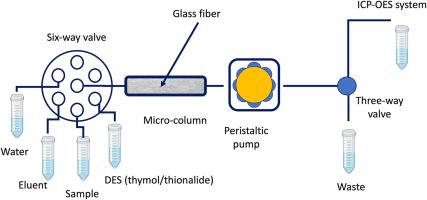Deep eutectic solvent as stationary phase for flow analysis: Automated trace metal determination in food products
IF 5.7
2区 化学
Q1 CHEMISTRY, ANALYTICAL
引用次数: 0
Abstract
Background
Deep eutectic solvents (DES) have emerged as effective solvents that address many challenges in analytical chemistry, particularly in microextraction. However, until now, their use has been primarily focused on extraction processes. This has significantly limited their application in analytical chemistry, especially in flow analysis, where the high viscosity of DES has made their use difficult.
Results
This paper presents a novel DES-based liquid-liquid microextraction approach for the separation and determination of trace metals in foods using an automated flow analysis system. In this study, a DES composed of thymol and thionalide was first prepared and thoroughly characterized by spectroscopic (IR, NMR) and differential scanning calorimetry techniques. The COSMO-SAC model was employed to predict the solubility of metal salts (Cu, Cd, Pb, and Hg) in the new DES. The solvent was applied to glass fiber as a stationary phase in an extraction column in a flow analysis. After microwave digestion of food samples, metals were extracted by this DES in an automated mode and subsequently eluted with an aqueous thiourea solution. The procedure demonstrated limits of detection (LOD) of 6 μg kg−1 for mercury, 4 μg kg−1 for copper, 6 μg kg−1 for lead and 0.6 μg kg−1 for cadmium.
Significance
This study represents the first application of a DES-based stationary phase in automated flow analysis, significantly enhancing extraction efficiency. The procedure enables precise and reliable determination of trace metals in food products, aligning with green chemistry principles by minimizing waste.


作为流动分析固定相的深共晶溶剂:食品中痕量金属的自动测定
背景深共晶溶剂(DES)是一种有效的溶剂,可以解决分析化学中的许多难题,尤其是在微萃取方面。然而,到目前为止,它们的使用主要集中在萃取过程中。结果本文介绍了一种基于 DES 的新型液液微萃取方法,该方法利用自动流动分析系统对食品中的痕量金属进行分离和测定。在这项研究中,首先制备了由百里酚和亚硫酰基组成的 DES,并通过光谱(红外、核磁共振)和差示扫描量热技术对其进行了全面表征。利用 COSMO-SAC 模型预测了金属盐(铜、镉、铅和汞)在新 DES 中的溶解度。在流动分析中,将溶剂应用于玻璃纤维作为萃取柱中的固定相。微波消解食品样品后,用这种 DES 自动萃取金属,然后用硫脲水溶液洗脱。该方法的检测限(LOD)分别为:汞 6 μg kg-1、铜 4 μg kg-1、铅 6 μg kg-1、镉 0.6 μg kg-1。该程序可精确可靠地测定食品中的痕量金属,最大限度地减少浪费,符合绿色化学原则。
本文章由计算机程序翻译,如有差异,请以英文原文为准。
求助全文
约1分钟内获得全文
求助全文
来源期刊

Analytica Chimica Acta
化学-分析化学
CiteScore
10.40
自引率
6.50%
发文量
1081
审稿时长
38 days
期刊介绍:
Analytica Chimica Acta has an open access mirror journal Analytica Chimica Acta: X, sharing the same aims and scope, editorial team, submission system and rigorous peer review.
Analytica Chimica Acta provides a forum for the rapid publication of original research, and critical, comprehensive reviews dealing with all aspects of fundamental and applied modern analytical chemistry. The journal welcomes the submission of research papers which report studies concerning the development of new and significant analytical methodologies. In determining the suitability of submitted articles for publication, particular scrutiny will be placed on the degree of novelty and impact of the research and the extent to which it adds to the existing body of knowledge in analytical chemistry.
 求助内容:
求助内容: 应助结果提醒方式:
应助结果提醒方式:


